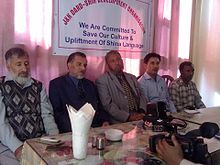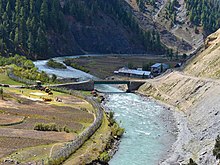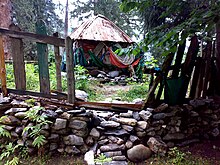Gurez
Gurez
Guráai Gurais | |
|---|---|
Tehsil | |
UTC+5:30 (IST) | |
| PIN | 193503 |
| Vehicle registration | JK-15 |
| Website | bandipore |
Gurez, or Gurais
The valley lies near the
Dawar is the central township in the area. The population of the area is estimated to be about 30,000, and is scattered among fifteen villages. Tourism industry is emerging , hotels like Gurez knights, kaka Palace, woodvibes provide service to tourists. Ji
Due to heavy snowfall (around 2 metres (7 ft)) and closure of Razdan Pass in winter, the valley remains cut off for six months of the year.[10]
Gurez is 143 km from srinagar. From Srinagar to Bandipore
it is 57 km via sumbal & from Bandipora to Gurez it is around 86 km totalling 143 km from Capital Srinagar. Gurez people speak shina & kashmiri & are totally influenced by kashmiri language & culture . Both shina & kashir (kashmiri ) are dardic languages & are understood
to each other to large extent. Due to its minuscule number of speakers can be considered as dialect of kashmiri language.
History
Historically, Gurez was part of ancient
The ancient capital of the
Prior to the partition of Kashmir, Gurez had been a destination for foreign tourists, including
Geography
While describing the Kishenganga Valley (Gurez), Walter R. Lawrence writes in his book The Valley of Kashmir,
"Perhaps Pahalgam, the village of the shepherds that stands at the head of the Liddar valley with its healthy forest of pines, and Gurez, which lies at a distance of thirty-five miles from Bandipora, the port of the Wular Lake, will before long rival in popularity the other margs. Gurez is a lovely valley five miles in length lying at an elevation of about 8000 feet above the sea. The Kishenganga river flows through it, and on either side are mountains. The climate is dry and mild, excellent English vegetables can be grown, and the wild raspberries and currants are delicious."[13]
"The valley is extremely picturesque, as the river comes dashing along through a rich meadow, partly covered with lindens, walnut and willow trees, while the mountains on either side present nothing but a succession of most abrupt precipices, and Alpine lodges, covered with fir trees."[14]
Habba Khatoon


Gurez's most formidable peak is Habba Khatoon, around which legends abound and at one time, even a film starring Dimple Kapadia was planned.[15] This pyramid shaped peak was named after the Kashmiri poet Habba Khatoon. She was a beautiful and intelligent woman from Saffron village chandhara, and originally known as "Zoon" (which means Moon in English). She was the daughter of a peasant Abuddi Rather, who married her to an illiterate peasant boy named Habba. Zoon was ill-treated by her mother-in-law and husband, because she spent most of her time in poetry and singing. Dejected by her plight, she changed her name to Habba Khatoon.
The emperor of Kashmir, Yousuf Shah Chak, was enthralled by her beauty, intelligence and poetry. He arranged her divorce from Habba and married her. According to the story, Shah Chak was imprisoned by his rival King Akbar, Habba Khatoon used to wander near the peak that now bears her name to look for her lover. After her husband's death, she wandered the banks of river Jhelum in mourning. She died twenty years later by drowning into the jhelum and now her tomb is at Athwajan.[16] [17] Habba Khatoon Drama club was founded in 1976 by the poet Late Hajji Abdul Aziz Samoon (Retired Police Officer; SSP). The club played a pivotal role in safeguarding the cultural ethos and traditions of the Dard-Shin tribe. Hajji Abdul Aziz Samoon(KPS) was also Chairman of Jammu and Kashmir Dard-Shina Development Organization (JKDSDO), a body representing Dard community in the state JKDSDO [18] [19]
Economy

Energy
There is no central electricity in Gurez, although, as of 2009, a
Because of the lack of electricity, there is no significant industrial activity in the valley. The only electricity which is available comes from a few diesel generators which provide power to some parts of the area in summer for an hour at a time. The Indian government's relocation plans are unclear, and it has not yet committed to providing hydroelectricity to those who will remain in the valley.[22]
Fishery
Kishenganga River, with a length of 150 kilometres (93 mi), supports world-class trout with an average weight of 11 kilograms (24 lb). As of 2006, there were plans to develop the fishery potential of the area, making it a resource for the surrounding region.
Fish in the river include:[23]
- Brown trout (Salmo trutta fario)
- Rainbow trout (Salmo gairdneri)
Demographics
According to the 2011 census of India, Gurez Tehsil had a population of 37,992 people with 22,978 males and 15,014 females. The number of Scheduled Castes and Scheduled Tribes numbered 104 and 31,094 respectively. Most of the people in Gurez speak Kashmiri and Shina.[1]
Religion


Gurez is majority
Islam is the largest religion in Gurez, followed by 84% of the people. Hinduism is the second-largest religion with 14.24% adherents. Sikhism and Christianity form 1.1% and 0.3% of the population respectively.[24]
Peer Baba

The Peer Baba came from Multan (Pakistan) in 1933 and established himself in a cave at Durmat, north of Kanzalwan. He was about 35 years old, and his religion is unknown. He is said to have fasted for months without taking any food or water. On occasion, he came down to Kanzalwan and asked for food in
Transportation
Air
There is a helipad in the tehsil headquarters
Rail
There is no railway connectivity to Gurez Valley. The nearest railway station is Sopore railway station located 115 kilometres from Dawar.
Road
The tehsil is connected to other places in Jammu and Kashmir and India by the Bandipora–Gurez Road. Road connectivity has been a major issue for the population due to their being heavy snowfall during the winter months. In 2015 the Border Roads Organisation had submitted a proposal to the Indian Central Government for the construction of a 18-km long tunnel that would ensure year long connectivity of the Gurez to the rest of the Kashmir Valley. However the project has not moved past the DPR stage.[27]
See also
References
- ^ a b c d "Bandipora district census" (PDF). Govt of India Census. Retrieved 13 July 2021.
- ^ Rashid, Hakeem Irfan. "Jammu and Kashmir Assembly dissolved". The Economic Times. Retrieved 22 November 2018.
- ^ "SDM Office Gurez". Twitter.
- ^ "The Jammu and Kashmir Official Languages Act, 2020" (PDF). The Gazette of India. 27 September 2020. Retrieved 27 September 2020.
- ^ "Parliament passes JK Official Languages Bill, 2020". Rising Kashmir. 23 September 2020. Retrieved 23 September 2020.
- ^ Spelt گُریز in Kashmiri and گورأى in Shina
- doi:10.5617/ao.7372. In this orthography áa represent a long a with a high falling pitch.
- ^ Benanav, Michael (17 September 2018). "A Journey to Kashmir's Gurez Valley". The New York Times.
- ^ "Gurez an introduction". 4 January 2008. Archived from the original on 10 July 2009.
- ^ Kumar, Sonali; Kumar, Prasenjeet (27 May 2017). The Outsider's Curse: A Memoir of the First "Outsider" Lady IAS Officer.
- ^ "Hidden paradise". 6 December 2008.
- ^ "GUREZ: KASHMIR: FIRST-HAND REPORT". 27 August 2007.
- ^ (P: 16)
- ^ Sir Charles Ellison Bates, 1872 AD
- ^ "Gurez: Kashmir Untouched". 4 March 2002.
- ^ Go to Kashmir. "About Gurez". Archived from the original on 21 November 2008. Retrieved 13 December 2009.
- ^ Kashmir Images. "Shina conference". Archived from the original on 5 October 2011. Retrieved 4 February 2012.
- ^ Greater Kashmir. "Shina Poet".
- ^ kashmirimages. "Dard community alleges discrimination". Archived from the original on 23 May 2012. Retrieved 26 October 2011.
- ^ "Electricity still a far-fetched dream for Gurez valley". 30 August 2009.
- ^ "Dammed if you do". May 2010. Archived from the original on 28 December 2010. Retrieved 8 January 2011.
- ^ "Dammed if you do". May 2010. Archived from the original on 28 December 2010. Retrieved 8 January 2011.
- ^ "Gippsland Aquaculture Industry Network GAIN". 2 September 2006. Archived from the original on 20 February 2012.
- ^ a b "Gurez Population". Census India. Retrieved 29 August 2020.
- ^ "Religion in Gurez". 14 June 2008. Archived from the original on 5 July 2009.
- ^ "Srinagar - Gurez chopper service introduced at Rs 3000".
- ^ "Proposed Gurez-Bandipora tunnel stuck at DPR stage".
